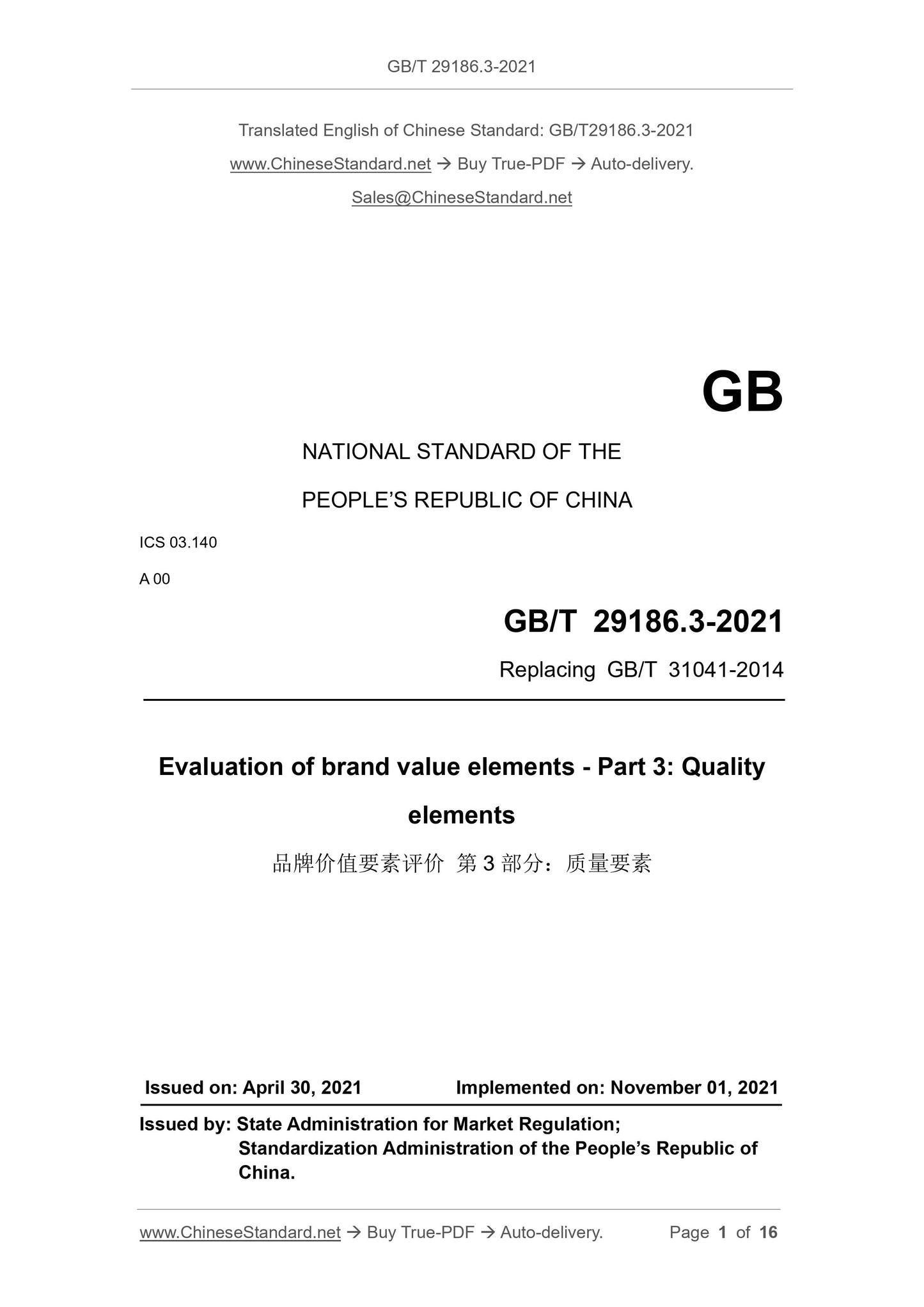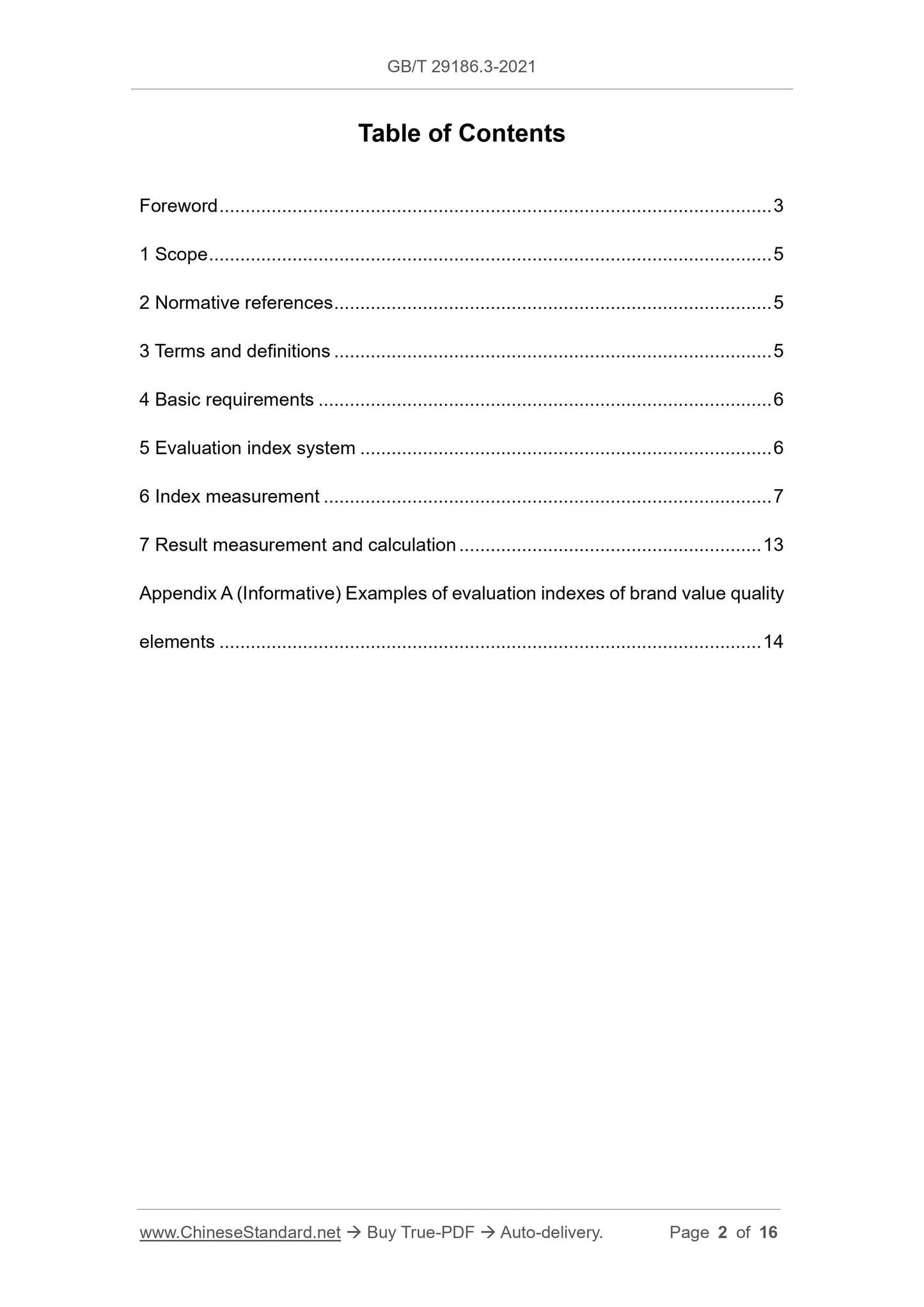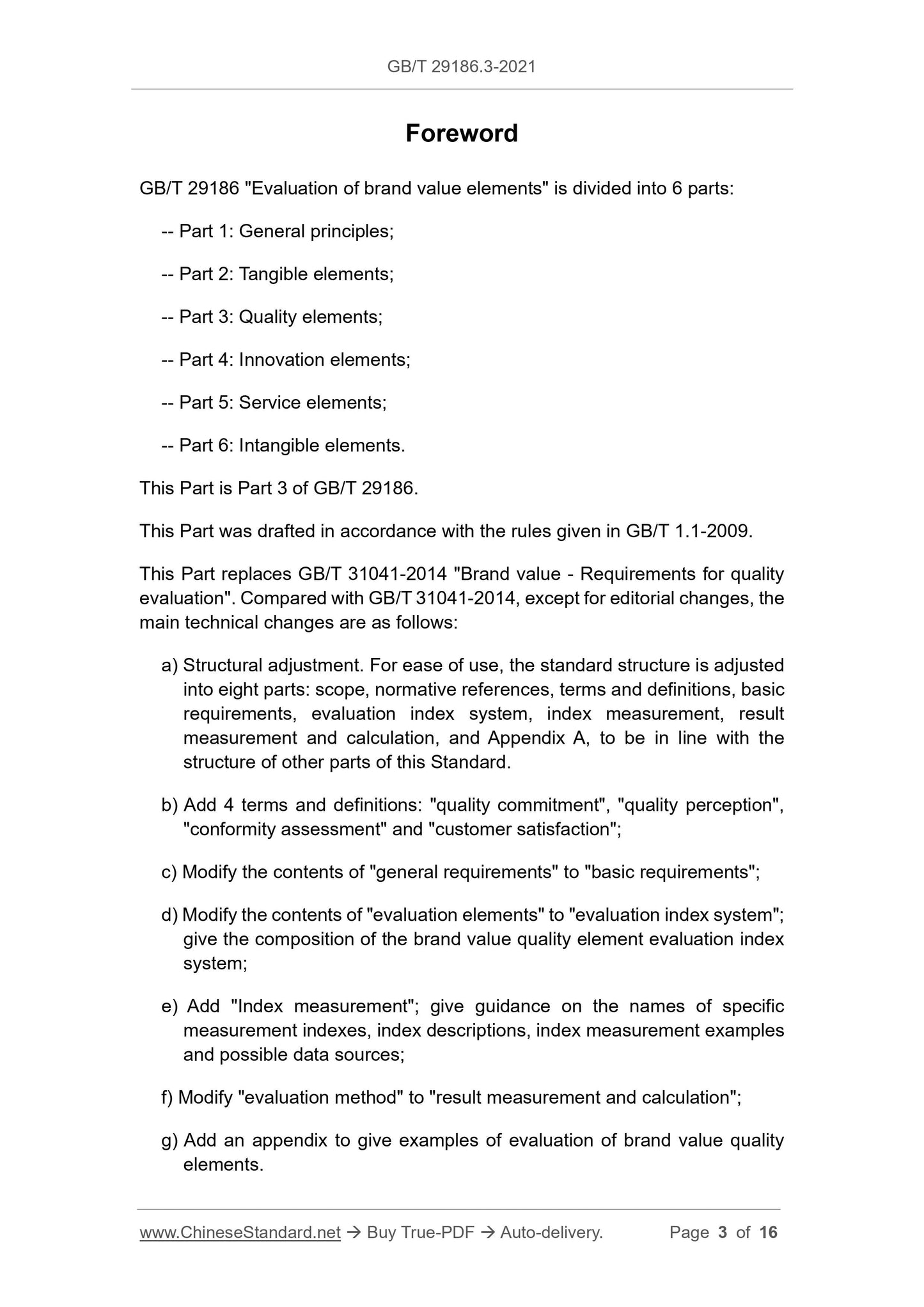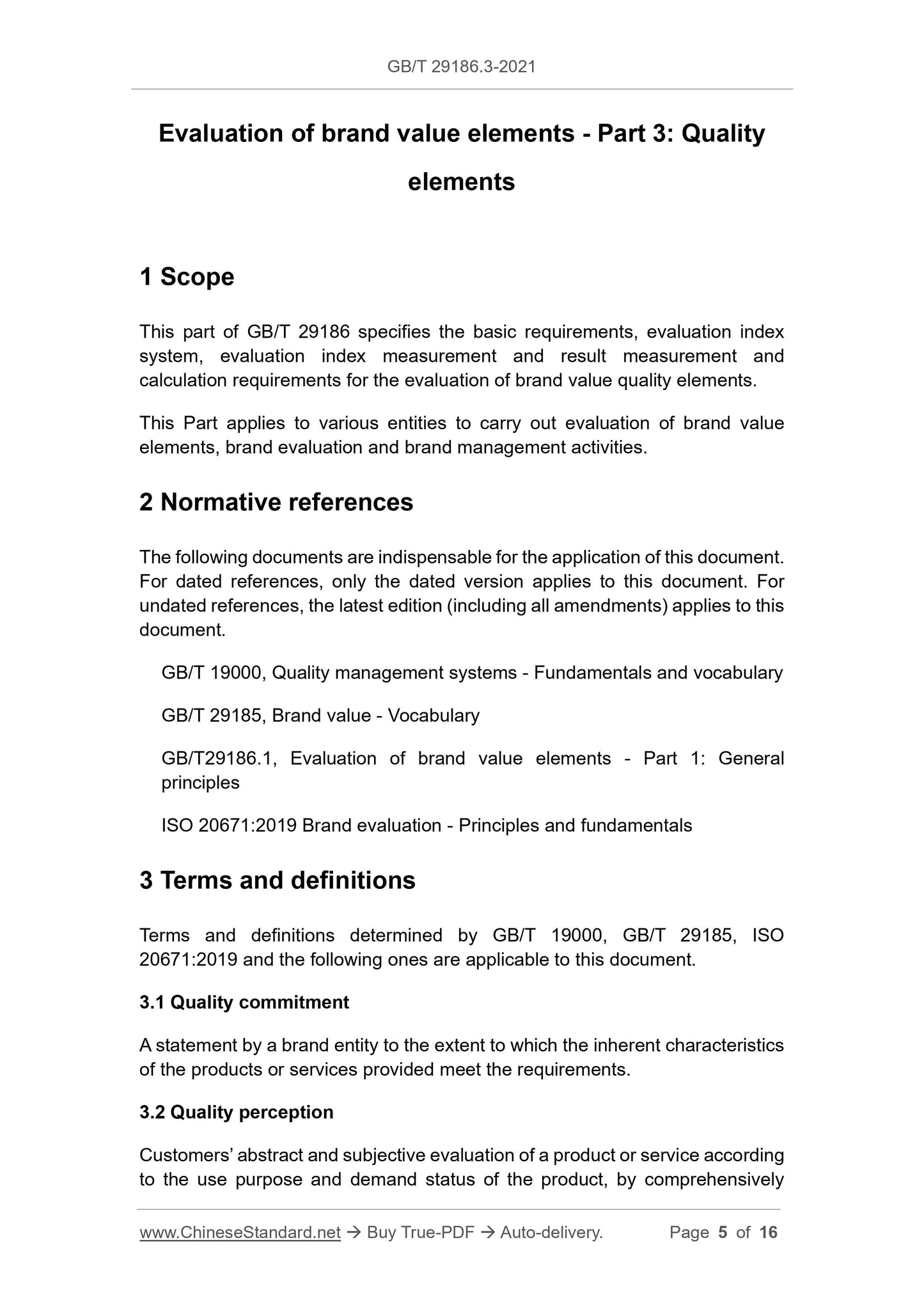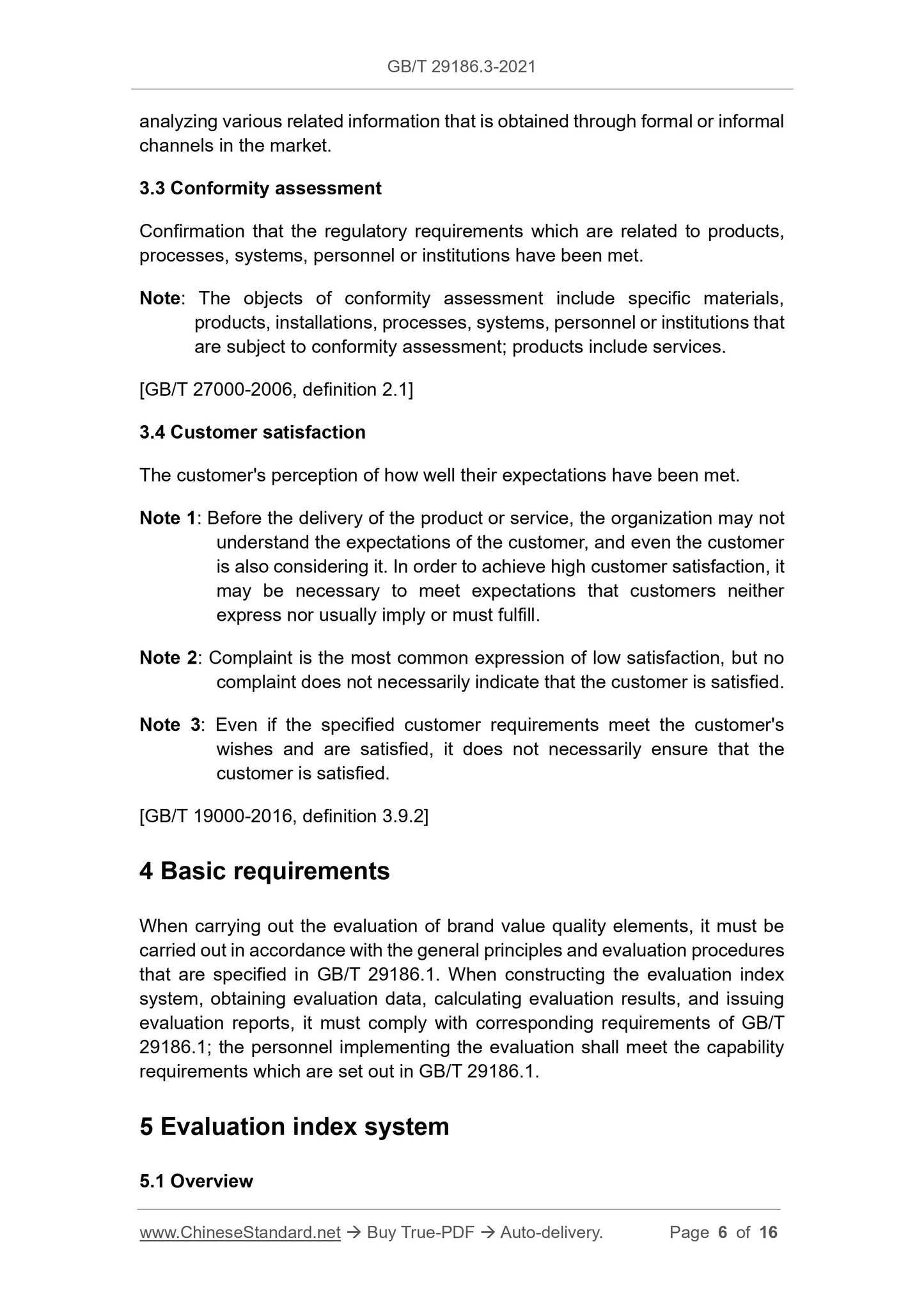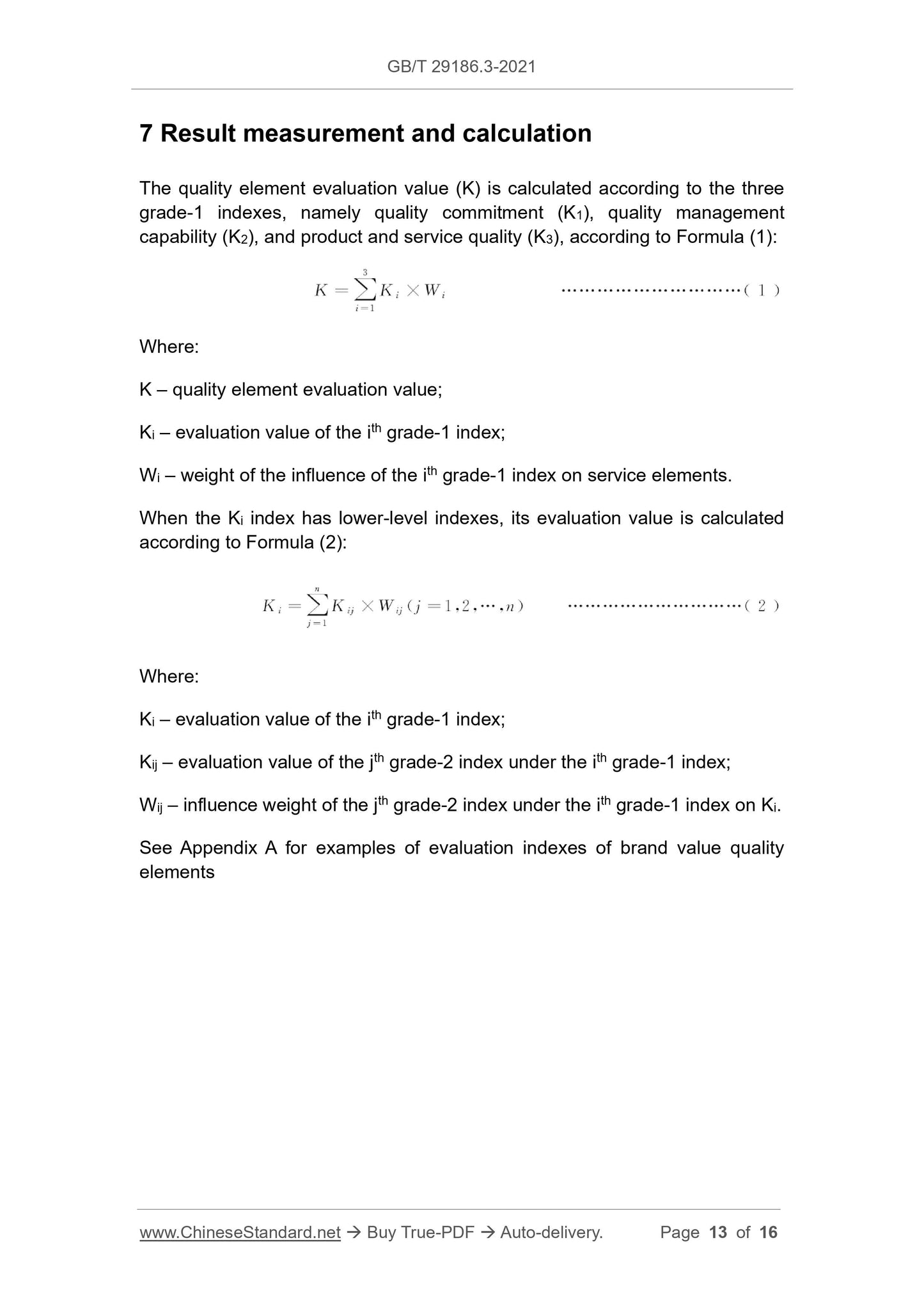1
/
of
6
www.ChineseStandard.us -- Field Test Asia Pte. Ltd.
GB/T 29186.3-2021 English PDF (GB/T29186.3-2021)
GB/T 29186.3-2021 English PDF (GB/T29186.3-2021)
Regular price
$200.00
Regular price
Sale price
$200.00
Unit price
/
per
Shipping calculated at checkout.
Couldn't load pickup availability
GB/T 29186.3-2021: Evaluation of brand value elements - Part 3: Quality elements
Delivery: 9 seconds. Download (& Email) true-PDF + Invoice.
Get Quotation: Click GB/T 29186.3-2021 (Self-service in 1-minute)
Historical versions (Master-website): GB/T 29186.3-2021
Preview True-PDF (Reload/Scroll-down if blank)
GB/T 29186.3-2021
GB
NATIONAL STANDARD OF THE
PEOPLE’S REPUBLIC OF CHINA
ICS 03.140
A 00
Replacing GB/T 31041-2014
Evaluation of brand value elements - Part 3: Quality
elements
ISSUED ON: APRIL 30, 2021
IMPLEMENTED ON: NOVEMBER 01, 2021
Issued by: State Administration for Market Regulation;
Standardization Administration of the People’s Republic of
China.
Table of Contents
Foreword ... 3
1 Scope ... 5
2 Normative references ... 5
3 Terms and definitions ... 5
4 Basic requirements ... 6
5 Evaluation index system ... 6
6 Index measurement ... 7
7 Result measurement and calculation ... 13
Appendix A (Informative) Examples of evaluation indexes of brand value quality
elements ... 14
Foreword
GB/T 29186 "Evaluation of brand value elements" is divided into 6 parts:
-- Part 1: General principles;
-- Part 2: Tangible elements;
-- Part 3: Quality elements;
-- Part 4: Innovation elements;
-- Part 5: Service elements;
-- Part 6: Intangible elements.
This Part is Part 3 of GB/T 29186.
This Part was drafted in accordance with the rules given in GB/T 1.1-2009.
This Part replaces GB/T 31041-2014 "Brand value - Requirements for quality
evaluation". Compared with GB/T 31041-2014, except for editorial changes, the
main technical changes are as follows:
a) Structural adjustment. For ease of use, the standard structure is adjusted
into eight parts: scope, normative references, terms and definitions, basic
requirements, evaluation index system, index measurement, result
measurement and calculation, and Appendix A, to be in line with the
structure of other parts of this Standard.
b) Add 4 terms and definitions: "quality commitment", "quality perception",
"conformity assessment" and "customer satisfaction";
c) Modify the contents of "general requirements" to "basic requirements";
d) Modify the contents of "evaluation elements" to "evaluation index system";
give the composition of the brand value quality element evaluation index
system;
e) Add "Index measurement"; give guidance on the names of specific
measurement indexes, index descriptions, index measurement examples
and possible data sources;
f) Modify "evaluation method" to "result measurement and calculation";
g) Add an appendix to give examples of evaluation of brand value quality
elements.
Evaluation of brand value elements - Part 3: Quality
elements
1 Scope
This part of GB/T 29186 specifies the basic requirements, evaluation index
system, evaluation index measurement and result measurement and
calculation requirements for the evaluation of brand value quality elements.
This Part applies to various entities to carry out evaluation of brand value
elements, brand evaluation and brand management activities.
2 Normative references
The following documents are indispensable for the application of this document.
For dated references, only the dated version applies to this document. For
undated references, the latest edition (including all amendments) applies to this
document.
GB/T 19000, Quality management systems - Fundamentals and vocabulary
GB/T 29185, Brand value - Vocabulary
GB/T29186.1, Evaluation of brand value elements - Part 1: General
principles
ISO 20671:2019 Brand evaluation - Principles and fundamentals
3 Terms and definitions
Terms and definitions determined by GB/T 19000, GB/T 29185, ISO
20671:2019 and the following ones are applicable to this document.
3.1 Quality commitment
A statement by a brand entity to the extent to which the inherent characteristics
of the products or services provided meet the requirements.
3.2 Quality perception
Customers’ abstract and subjective evaluation of a product or service according
to the use purpose and demand status of the product, by comprehensively
analyzing various related information that is obtained through formal or informal
channels in the market.
3.3 Conformity assessment
Confirmation that the regulatory requirements which are related to products,
processes, systems, personnel or institutions have been met.
Note: The objects of conformity assessment include specific materials,
products, installations, processes, systems, personnel or institutions that
are subject to conformity assessment; products include services.
[GB/T 27000-2006, definition 2.1]
3.4 Customer satisfaction
The customer's perception of how well their expectations have been met.
Note 1: Before the delivery of the product or service, the organization may not
understand the expectations of the customer, and even the customer
is also considering it. In order to achieve high customer satisfaction, it
may be necessary to meet expectations that customers neither
express nor usually imply or must fulfill.
Note 2: Complaint is the most common expression of low satisfaction, but no
complaint does not necessarily indicate that the customer is satisfied.
Note 3: Even if the specified customer requirements meet the customer's
wishes and are satisfied, it does not necessarily ensure that the
customer is satisfied.
[GB/T 19000-2016, definition 3.9.2]
4 Basic requirements
When carrying out the evaluation of brand value quality elements, it must be
carried out in accordance with the general principles and evaluation procedures
that are specified in GB/T 29186.1. When constructing the evaluation index
system, obtaining evaluation data, calculating evaluation results, and issuing
evaluation reports, it must comply with corresponding requirements of GB/T
29186.1; the personnel implementing the evaluation shall meet the capability
requirements which are set out in GB/T 29186.1.
5 Evaluation index system
5.1 Overview
7 Result measurement and calculation
The quality element evaluation value (K) is calculated according to the three
grade-1 indexes, namely quality commitment (K1), quality management
capability (K2), and product and service quality (K3), according to Formula (1):
Where:
K – quality element evaluation value;
Ki – evaluation value of the ith grade-1 index;
Wi – weight of the influence of the ith grade-1 index on service elements.
When the Ki index has lower-level indexes, its evaluation value is calculated
according to Formula (2):
Where:
Ki – evaluation value of the ith grade-1 index;
Kij – evaluation value of the jth grade-2 index under the ith grade-1 index;
Wij – influence weight of the jth grade-2 index under the ith grade-1 index on Ki.
See Appendix A for examples of evaluation indexes of brand value quality
elements
GB/T 29186.3-2021
GB
NATIONAL STANDARD OF THE
PEOPLE’S REPUBLIC OF CHINA
ICS 03.140
A 00
Replacing GB/T 31041-2014
Evaluation of brand value elements - Part 3: Quality
elements
ISSUED ON: APRIL 30, 2021
IMPLEMENTED ON: NOVEMBER 01, 2021
Issued by: State Administration for Market Regulation;
Standardization Administration of the People’s Republic of
China.
Table of Contents
Foreword ... 3
1 Scope ... 5
2 Normative references ... 5
3 Terms and definitions ... 5
4 Basic requirements ... 6
5 Evaluation index system ... 6
6 Index measurement ... 7
7 Result measurement and calculation ... 13
Appendix A (Informative) Examples of evaluation indexes of brand value quality
elements ... 14
Foreword
GB/T 29186 "Evaluation of brand value elements" is divided into 6 parts:
-- Part 1: General principles;
-- Part 2: Tangible elements;
-- Part 3: Quality elements;
-- Part 4: Innovation elements;
-- Part 5: Service elements;
-- Part 6: Intangible elements.
This Part is Part 3 of GB/T 29186.
This Part was drafted in accordance with the rules given in GB/T 1.1-2009.
This Part replaces GB/T 31041-2014 "Brand value - Requirements for quality
evaluation". Compared with GB/T 31041-2014, except for editorial changes, the
main technical changes are as follows:
a) Structural adjustment. For ease of use, the standard structure is adjusted
into eight parts: scope, normative references, terms and definitions, basic
requirements, evaluation index system, index measurement, result
measurement and calculation, and Appendix A, to be in line with the
structure of other parts of this Standard.
b) Add 4 terms and definitions: "quality commitment", "quality perception",
"conformity assessment" and "customer satisfaction";
c) Modify the contents of "general requirements" to "basic requirements";
d) Modify the contents of "evaluation elements" to "evaluation index system";
give the composition of the brand value quality element evaluation index
system;
e) Add "Index measurement"; give guidance on the names of specific
measurement indexes, index descriptions, index measurement examples
and possible data sources;
f) Modify "evaluation method" to "result measurement and calculation";
g) Add an appendix to give examples of evaluation of brand value quality
elements.
Evaluation of brand value elements - Part 3: Quality
elements
1 Scope
This part of GB/T 29186 specifies the basic requirements, evaluation index
system, evaluation index measurement and result measurement and
calculation requirements for the evaluation of brand value quality elements.
This Part applies to various entities to carry out evaluation of brand value
elements, brand evaluation and brand management activities.
2 Normative references
The following documents are indispensable for the application of this document.
For dated references, only the dated version applies to this document. For
undated references, the latest edition (including all amendments) applies to this
document.
GB/T 19000, Quality management systems - Fundamentals and vocabulary
GB/T 29185, Brand value - Vocabulary
GB/T29186.1, Evaluation of brand value elements - Part 1: General
principles
ISO 20671:2019 Brand evaluation - Principles and fundamentals
3 Terms and definitions
Terms and definitions determined by GB/T 19000, GB/T 29185, ISO
20671:2019 and the following ones are applicable to this document.
3.1 Quality commitment
A statement by a brand entity to the extent to which the inherent characteristics
of the products or services provided meet the requirements.
3.2 Quality perception
Customers’ abstract and subjective evaluation of a product or service according
to the use purpose and demand status of the product, by comprehensively
analyzing various related information that is obtained through formal or informal
channels in the market.
3.3 Conformity assessment
Confirmation that the regulatory requirements which are related to products,
processes, systems, personnel or institutions have been met.
Note: The objects of conformity assessment include specific materials,
products, installations, processes, systems, personnel or institutions that
are subject to conformity assessment; products include services.
[GB/T 27000-2006, definition 2.1]
3.4 Customer satisfaction
The customer's perception of how well their expectations have been met.
Note 1: Before the delivery of the product or service, the organization may not
understand the expectations of the customer, and even the customer
is also considering it. In order to achieve high customer satisfaction, it
may be necessary to meet expectations that customers neither
express nor usually imply or must fulfill.
Note 2: Complaint is the most common expression of low satisfaction, but no
complaint does not necessarily indicate that the customer is satisfied.
Note 3: Even if the specified customer requirements meet the customer's
wishes and are satisfied, it does not necessarily ensure that the
customer is satisfied.
[GB/T 19000-2016, definition 3.9.2]
4 Basic requirements
When carrying out the evaluation of brand value quality elements, it must be
carried out in accordance with the general principles and evaluation procedures
that are specified in GB/T 29186.1. When constructing the evaluation index
system, obtaining evaluation data, calculating evaluation results, and issuing
evaluation reports, it must comply with corresponding requirements of GB/T
29186.1; the personnel implementing the evaluation shall meet the capability
requirements which are set out in GB/T 29186.1.
5 Evaluation index system
5.1 Overview
7 Result measurement and calculation
The quality element evaluation value (K) is calculated according to the three
grade-1 indexes, namely quality commitment (K1), quality management
capability (K2), and product and service quality (K3), according to Formula (1):
Where:
K – quality element evaluation value;
Ki – evaluation value of the ith grade-1 index;
Wi – weight of the influence of the ith grade-1 index on service elements.
When the Ki index has lower-level indexes, its evaluation value is calculated
according to Formula (2):
Where:
Ki – evaluation value of the ith grade-1 index;
Kij – evaluation value of the jth grade-2 index under the ith grade-1 index;
Wij – influence weight of the jth grade-2 index under the ith grade-1 index on Ki.
See Appendix A for examples of evaluation indexes of brand value quality
elements
Delivery: 9 seconds. Download (& Email) true-PDF + Invoice.
Get Quotation: Click GB/T 29186.3-2021 (Self-service in 1-minute)
Historical versions (Master-website): GB/T 29186.3-2021
Preview True-PDF (Reload/Scroll-down if blank)
GB/T 29186.3-2021
GB
NATIONAL STANDARD OF THE
PEOPLE’S REPUBLIC OF CHINA
ICS 03.140
A 00
Replacing GB/T 31041-2014
Evaluation of brand value elements - Part 3: Quality
elements
ISSUED ON: APRIL 30, 2021
IMPLEMENTED ON: NOVEMBER 01, 2021
Issued by: State Administration for Market Regulation;
Standardization Administration of the People’s Republic of
China.
Table of Contents
Foreword ... 3
1 Scope ... 5
2 Normative references ... 5
3 Terms and definitions ... 5
4 Basic requirements ... 6
5 Evaluation index system ... 6
6 Index measurement ... 7
7 Result measurement and calculation ... 13
Appendix A (Informative) Examples of evaluation indexes of brand value quality
elements ... 14
Foreword
GB/T 29186 "Evaluation of brand value elements" is divided into 6 parts:
-- Part 1: General principles;
-- Part 2: Tangible elements;
-- Part 3: Quality elements;
-- Part 4: Innovation elements;
-- Part 5: Service elements;
-- Part 6: Intangible elements.
This Part is Part 3 of GB/T 29186.
This Part was drafted in accordance with the rules given in GB/T 1.1-2009.
This Part replaces GB/T 31041-2014 "Brand value - Requirements for quality
evaluation". Compared with GB/T 31041-2014, except for editorial changes, the
main technical changes are as follows:
a) Structural adjustment. For ease of use, the standard structure is adjusted
into eight parts: scope, normative references, terms and definitions, basic
requirements, evaluation index system, index measurement, result
measurement and calculation, and Appendix A, to be in line with the
structure of other parts of this Standard.
b) Add 4 terms and definitions: "quality commitment", "quality perception",
"conformity assessment" and "customer satisfaction";
c) Modify the contents of "general requirements" to "basic requirements";
d) Modify the contents of "evaluation elements" to "evaluation index system";
give the composition of the brand value quality element evaluation index
system;
e) Add "Index measurement"; give guidance on the names of specific
measurement indexes, index descriptions, index measurement examples
and possible data sources;
f) Modify "evaluation method" to "result measurement and calculation";
g) Add an appendix to give examples of evaluation of brand value quality
elements.
Evaluation of brand value elements - Part 3: Quality
elements
1 Scope
This part of GB/T 29186 specifies the basic requirements, evaluation index
system, evaluation index measurement and result measurement and
calculation requirements for the evaluation of brand value quality elements.
This Part applies to various entities to carry out evaluation of brand value
elements, brand evaluation and brand management activities.
2 Normative references
The following documents are indispensable for the application of this document.
For dated references, only the dated version applies to this document. For
undated references, the latest edition (including all amendments) applies to this
document.
GB/T 19000, Quality management systems - Fundamentals and vocabulary
GB/T 29185, Brand value - Vocabulary
GB/T29186.1, Evaluation of brand value elements - Part 1: General
principles
ISO 20671:2019 Brand evaluation - Principles and fundamentals
3 Terms and definitions
Terms and definitions determined by GB/T 19000, GB/T 29185, ISO
20671:2019 and the following ones are applicable to this document.
3.1 Quality commitment
A statement by a brand entity to the extent to which the inherent characteristics
of the products or services provided meet the requirements.
3.2 Quality perception
Customers’ abstract and subjective evaluation of a product or service according
to the use purpose and demand status of the product, by comprehensively
analyzing various related information that is obtained through formal or informal
channels in the market.
3.3 Conformity assessment
Confirmation that the regulatory requirements which are related to products,
processes, systems, personnel or institutions have been met.
Note: The objects of conformity assessment include specific materials,
products, installations, processes, systems, personnel or institutions that
are subject to conformity assessment; products include services.
[GB/T 27000-2006, definition 2.1]
3.4 Customer satisfaction
The customer's perception of how well their expectations have been met.
Note 1: Before the delivery of the product or service, the organization may not
understand the expectations of the customer, and even the customer
is also considering it. In order to achieve high customer satisfaction, it
may be necessary to meet expectations that customers neither
express nor usually imply or must fulfill.
Note 2: Complaint is the most common expression of low satisfaction, but no
complaint does not necessarily indicate that the customer is satisfied.
Note 3: Even if the specified customer requirements meet the customer's
wishes and are satisfied, it does not necessarily ensure that the
customer is satisfied.
[GB/T 19000-2016, definition 3.9.2]
4 Basic requirements
When carrying out the evaluation of brand value quality elements, it must be
carried out in accordance with the general principles and evaluation procedures
that are specified in GB/T 29186.1. When constructing the evaluation index
system, obtaining evaluation data, calculating evaluation results, and issuing
evaluation reports, it must comply with corresponding requirements of GB/T
29186.1; the personnel implementing the evaluation shall meet the capability
requirements which are set out in GB/T 29186.1.
5 Evaluation index system
5.1 Overview
7 Result measurement and calculation
The quality element evaluation value (K) is calculated according to the three
grade-1 indexes, namely quality commitment (K1), quality management
capability (K2), and product and service quality (K3), according to Formula (1):
Where:
K – quality element evaluation value;
Ki – evaluation value of the ith grade-1 index;
Wi – weight of the influence of the ith grade-1 index on service elements.
When the Ki index has lower-level indexes, its evaluation value is calculated
according to Formula (2):
Where:
Ki – evaluation value of the ith grade-1 index;
Kij – evaluation value of the jth grade-2 index under the ith grade-1 index;
Wij – influence weight of the jth grade-2 index under the ith grade-1 index on Ki.
See Appendix A for examples of evaluation indexes of brand value quality
elements
GB/T 29186.3-2021
GB
NATIONAL STANDARD OF THE
PEOPLE’S REPUBLIC OF CHINA
ICS 03.140
A 00
Replacing GB/T 31041-2014
Evaluation of brand value elements - Part 3: Quality
elements
ISSUED ON: APRIL 30, 2021
IMPLEMENTED ON: NOVEMBER 01, 2021
Issued by: State Administration for Market Regulation;
Standardization Administration of the People’s Republic of
China.
Table of Contents
Foreword ... 3
1 Scope ... 5
2 Normative references ... 5
3 Terms and definitions ... 5
4 Basic requirements ... 6
5 Evaluation index system ... 6
6 Index measurement ... 7
7 Result measurement and calculation ... 13
Appendix A (Informative) Examples of evaluation indexes of brand value quality
elements ... 14
Foreword
GB/T 29186 "Evaluation of brand value elements" is divided into 6 parts:
-- Part 1: General principles;
-- Part 2: Tangible elements;
-- Part 3: Quality elements;
-- Part 4: Innovation elements;
-- Part 5: Service elements;
-- Part 6: Intangible elements.
This Part is Part 3 of GB/T 29186.
This Part was drafted in accordance with the rules given in GB/T 1.1-2009.
This Part replaces GB/T 31041-2014 "Brand value - Requirements for quality
evaluation". Compared with GB/T 31041-2014, except for editorial changes, the
main technical changes are as follows:
a) Structural adjustment. For ease of use, the standard structure is adjusted
into eight parts: scope, normative references, terms and definitions, basic
requirements, evaluation index system, index measurement, result
measurement and calculation, and Appendix A, to be in line with the
structure of other parts of this Standard.
b) Add 4 terms and definitions: "quality commitment", "quality perception",
"conformity assessment" and "customer satisfaction";
c) Modify the contents of "general requirements" to "basic requirements";
d) Modify the contents of "evaluation elements" to "evaluation index system";
give the composition of the brand value quality element evaluation index
system;
e) Add "Index measurement"; give guidance on the names of specific
measurement indexes, index descriptions, index measurement examples
and possible data sources;
f) Modify "evaluation method" to "result measurement and calculation";
g) Add an appendix to give examples of evaluation of brand value quality
elements.
Evaluation of brand value elements - Part 3: Quality
elements
1 Scope
This part of GB/T 29186 specifies the basic requirements, evaluation index
system, evaluation index measurement and result measurement and
calculation requirements for the evaluation of brand value quality elements.
This Part applies to various entities to carry out evaluation of brand value
elements, brand evaluation and brand management activities.
2 Normative references
The following documents are indispensable for the application of this document.
For dated references, only the dated version applies to this document. For
undated references, the latest edition (including all amendments) applies to this
document.
GB/T 19000, Quality management systems - Fundamentals and vocabulary
GB/T 29185, Brand value - Vocabulary
GB/T29186.1, Evaluation of brand value elements - Part 1: General
principles
ISO 20671:2019 Brand evaluation - Principles and fundamentals
3 Terms and definitions
Terms and definitions determined by GB/T 19000, GB/T 29185, ISO
20671:2019 and the following ones are applicable to this document.
3.1 Quality commitment
A statement by a brand entity to the extent to which the inherent characteristics
of the products or services provided meet the requirements.
3.2 Quality perception
Customers’ abstract and subjective evaluation of a product or service according
to the use purpose and demand status of the product, by comprehensively
analyzing various related information that is obtained through formal or informal
channels in the market.
3.3 Conformity assessment
Confirmation that the regulatory requirements which are related to products,
processes, systems, personnel or institutions have been met.
Note: The objects of conformity assessment include specific materials,
products, installations, processes, systems, personnel or institutions that
are subject to conformity assessment; products include services.
[GB/T 27000-2006, definition 2.1]
3.4 Customer satisfaction
The customer's perception of how well their expectations have been met.
Note 1: Before the delivery of the product or service, the organization may not
understand the expectations of the customer, and even the customer
is also considering it. In order to achieve high customer satisfaction, it
may be necessary to meet expectations that customers neither
express nor usually imply or must fulfill.
Note 2: Complaint is the most common expression of low satisfaction, but no
complaint does not necessarily indicate that the customer is satisfied.
Note 3: Even if the specified customer requirements meet the customer's
wishes and are satisfied, it does not necessarily ensure that the
customer is satisfied.
[GB/T 19000-2016, definition 3.9.2]
4 Basic requirements
When carrying out the evaluation of brand value quality elements, it must be
carried out in accordance with the general principles and evaluation procedures
that are specified in GB/T 29186.1. When constructing the evaluation index
system, obtaining evaluation data, calculating evaluation results, and issuing
evaluation reports, it must comply with corresponding requirements of GB/T
29186.1; the personnel implementing the evaluation shall meet the capability
requirements which are set out in GB/T 29186.1.
5 Evaluation index system
5.1 Overview
7 Result measurement and calculation
The quality element evaluation value (K) is calculated according to the three
grade-1 indexes, namely quality commitment (K1), quality management
capability (K2), and product and service quality (K3), according to Formula (1):
Where:
K – quality element evaluation value;
Ki – evaluation value of the ith grade-1 index;
Wi – weight of the influence of the ith grade-1 index on service elements.
When the Ki index has lower-level indexes, its evaluation value is calculated
according to Formula (2):
Where:
Ki – evaluation value of the ith grade-1 index;
Kij – evaluation value of the jth grade-2 index under the ith grade-1 index;
Wij – influence weight of the jth grade-2 index under the ith grade-1 index on Ki.
See Appendix A for examples of evaluation indexes of brand value quality
elements
Share
